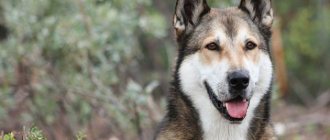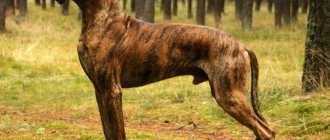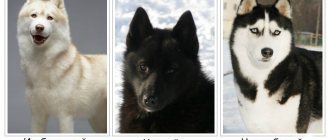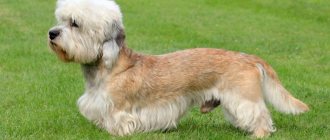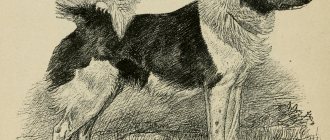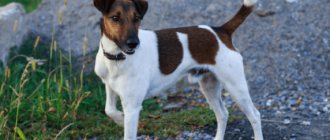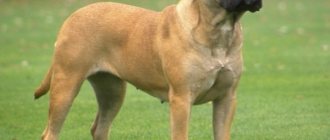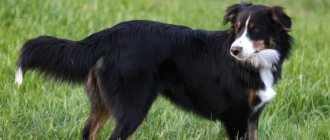brief information
- Country of origin: Germany, Baden-Württemberg, city of Leonberg.
- FCI class: group 2 (Pinchers, Schnauzers, Molossians, Swiss Cattle Dogs, etc.). Standard No. 145 dated September 20, 2002
- Purpose: guard dog, family dog, companion.
- Main color: all shades of red with a mandatory black mask.
- Life expectancy: 9-12 years.
- Average weight: from 40 to 75 kg, males are larger than females.
- Height: males from 70 to 85 cm, females from 65 to 80 cm.
- Cost: from 30,000 to 70,000 rubles.
Photo: pexels.com
Purpose
Leonbergers were originally used by peasants and shepherds as working dogs. Animals guarded flocks and houses, transported carts with luggage and played the role of rescuers on the water.
life-saving qualities to this day, and the influx of Newfoundland blood strengthened their abilities and gave membranes between their toes, thanks to which Leons became excellent swimmers.
Today, these amazing animals are primarily family companion dogs. Possessing an even and gentle disposition, imperturbable giants try to please their owner in everything, harnessing themselves to the household, looking after children, and at the same time they are perfectly trainable. This is a very obedient and easily controlled dog, with whom you can always come to an agreement.
History of the origin of the breed
In the first half of the 19th century, a member of the city council of the small town of Leonberg, Heinrich Essig, became concerned with creating a breed of dog that resembled a lion. His goal is to combine in the breed his love for animals and his hometown, on the coat of arms of which was the king of beasts. The basis was taken: a Newfoundland female and a St. Bernard male. Next, the Pyrenees Mountain Dog was used in the selection. The result is huge fluffy dogs with white and gray fur.
But the official’s goal was to create an animal that would resemble a lion in its appearance and dimensions. Selection continued, and the first red representatives of the breed appeared in 1846.
The majestic dogs were loved by representatives of the local nobility; they were used by farmers for protection and as draft power. Little Leonbergers were distributed around the world as gifts, winning people's hearts with their kindness and lack of aggression.
During the world wars, the breed experienced difficult times, almost approaching extinction. In the modern world, Leonbergers are known mainly to professionals and amateurs of the breed.
Photo: wikimedia.org
History of the origin of Leonbergers
The dog was named after the German town of Leonberg, thanks to whose mayor, Heinrich Essig, the breed appeared. In the 30s and 40s of the 19th century, he began breeding a completely new type of large-sized dog, which was supposed to be similar to the mountain lion that appeared on the city’s coat of arms.
At first, Henry crossed a Saint Bernard male with a Newfoundland female. After some time, the Pyrenean mountain dog was added to this tandem. Thanks to this innovation, puppies were born whose coloring was silver-gray, and a black mask stood out on their muzzle. Essig wanted to achieve a warmer canine coloring, so he continued to experiment. As a result, Leonbergers received a lion-colored coat, with which the breed was registered in 1846.
Essig, without wasting any time, began to advertise his bred quadrupeds among the aristocratic elite. Thus, the Leonbergers began to live at the court of Napoleon III, with the Empress Sissi of Austria-Hungary, they were the favorites of Richard Wagner and other elites. Less than 10 years later, the breed became very popular, so the Leonberg kennel began to generate good income, because the puppies were decently priced.
Interesting fact: This dog breed was officially recognized by the FCI in 1905.
Leonbergers were first brought to our country only in 1989. Only eight purebred dogs managed to survive the Second World War, and only three were capable of procreation. Now the number of these dogs has recovered, but in Russia they are not very popular, although domestic kennels have been opened where the dogs meet all the standards.
Description of the breed
The Leonberger is a very large, muscular, but elegant dog. Giants are distinguished by their proportional build, absolute self-confidence, and a calm but not apathetic temperament. Surprisingly, huge males are calm towards other animals, rarely show aggression and get along well with children.
Standard
- proportions: it is important that the ratio of the height at the withers to the length of the body is 9:10, and the depth of the chest is about 50% of the height at the withers;
- head: the length of the muzzle and skull should be almost the same; the skin should fit snugly, without forming folds or sagging;
- skull: slightly convex, powerful, but not heavy;
- nose lobe: black;
- lips: fit tightly, black, corners do not droop;
- jaws: developed, scissor bite, but a straight one is acceptable”;
- teeth: set – 42 teeth, absence of M3 is acceptable;
- eyes: shape – oval, size – medium, color – shades of brown (preferably dark). the eyelids are tightly fitted, without visible conjunctiva. The whites should not be red;
- ears: high set, without moving back. Hanging, with a tight fit to the head. Size – medium, fleshy;
- neck: smooth connection with the withers. Long, has no dewlap or dewlap;
- chest: deep, wide, at the elbow level, oval in shape;
- belly: slightly tucked;
- tail: hangs down when standing, curved and raised when moving;
- limbs: very muscular and strong, straight;
- movements: sweeping, equally smooth at all gaits, with a large grip of the front legs and a strong push of the hind legs;
- coat: abundant coat, with thick undercoat;
- color: all shades of red, yellow (lion) with a mandatory black mask.
Rock defects
- cowardice, unmotivated aggression;
- anatomical defects (hunchback, forelimbs that are too turned out, small joint angles, etc.);
- brown nose;
- severe lip depigment;
- lack of teeth (exception – M3);
- undershot, undershot;
- coat and eye color is not within the standard;
- ring tail;
- brown paw pads;
- no black mask;
- a large amount of white fur pigment (on the paws or chest) or in unacceptable places.
View this post on Instagram
Posted by Ivaholes (@ivaholes) Aug 2, 2021 at 1:50 am PDT
History of the Leonberger breed
Leonberger
Leonberger is a breed that owes its origin to a German official, and its name to the city of Leonberg, in southwestern Germany. In any case, this version is the most widespread. Somewhere between the 30s and 40s of the 19th century, the mayor of Leonberg, Heinrich Essig, set out to breed a completely new type of large dog. According to the breeder's idea, the breed was supposed to resemble the appearance of a mountain lion, which in turn was the heraldic symbol of the city.
Initially, a Newfoundland female and a St. Bernard male took part in the selection experiments. A few years later, a Pyrenean mountain dog joined this “love duet”, which made Essig the owner of a litter of several shaggy puppies with silver-gray coat color and a black mask on their faces. The breeder was not satisfied with this arrangement, so the experiments had to be continued. Leonbergers eventually adopted the warmer, leonine tones of the dog, which they were registered with in 1848.
At some point, vanity and a thirst for financial gain began to speak in Essig, so, without hesitation for a long time, the official began to promote his charges in aristocratic circles. So Leonbergers appeared at the court of Napoleon III, in the boudoir of the Austro-Hungarian Empress Sissi, in the mansion of Richard Wagner and other representatives of the elite. Less than ten years later, the Swabian mayor's pets turned out to be an extremely sought after product. Now, in order to acquire a shaggy lump from the nursery of the Leonberg mayor, you had to shell out a tidy sum.
Unfortunately, after his death in 1889, Heinrich Essig left neither a clear description of the appearance of Leonbergers nor breeding books, which gave rise to the emergence of other interesting versions of the origin of animals. In particular, some experts argued that the Leonberger is not an independent breed, but simply a more advanced version of the ancient German Hovawarts, which were on the verge of extinction in the 19th century. As evidence, supporters of the theory even cited the names of several breeders of that time who were involved in restoring the gene pool of endangered animals, which, as it later turned out, included the mayor of Leonberg.
The first Leonberger came to Russia only in 1989. The Second World War had its effect, which only eight purebred representatives of this family survived in Germany, and only three of them turned out to be suitable for breeding. By the way, despite the fact that the number of animals today has been completely restored, in our country the breed is not yet among the top most popular. Nevertheless, the gene pool of domestic nurseries meets all the requirements of current standards, which allows Leonbergers made in Russia to be exhibited and receive champion diplomas not only at European, but also at world exhibitions.
Character and behavioral characteristics
Leonberger is one of the most accommodating, good-natured and reasonable dog breeds. Nature has given the “lion cubs” loyalty to humans; in the family they never fight for authority with the owner. Although Leonbergers are often used as family and territory guards, they do not have such qualities as suspicion of strangers or a sense of “own territory”. Huge size, especially in males, is in itself a warning to attackers. But you shouldn’t think that these dogs are lumps, capable of protecting only as a last resort - prudence and a sober assessment of the situation are constant companions of giants.
Unmotivated aggression is a sign of mental illness, which is rare, since almost all representatives of the breed in our country are pupils of specialized clubs that do not allow individuals with such defects to be bred.
The character trait is long-suffering, somewhat phlegmatic. These traits allow Leonbergers to get along well with children and tolerate loud and energetic games. In reality, all that can threaten a child when interacting with such a giant is physical injury from being run over by a dog during play. Such dogs are not aggressive towards strangers, but are cautious.
They are rather indifferent to other animals. Leons are of little interest in small animals, but if necessary, a rebuff will be given to the provocateur.
The dog's huge size and phlegmatic character suggest that it does not need frequent human contact and can entertain itself on its own. This is wrong. Leons become depressed and stop eating when there is no human contact.
Leonberger character
The Leonberger has always been and remains a family dog, responsible for children, home and household. Leon, being an intelligent dog, does not require special training, but only education. You need to make friends with him, talk or just look into his eyes, and he will understand without words what they want from him.
The Leonberger is a dog with a knowing look. For children, he will be a large and soft toy, but in fact, he will seriously, patiently and responsibly monitor their safety. Leonberger is a companion, and he likes nothing more than a company where he is affectionately patted, stroked and admired.
They are calm, but at the same time playful, strong, but not aggressive and not prone to dominance. In addition, Leonbergers are excellent swimmers and will happily join family recreation on the water.
Leonbergers are irreplaceable as guards, because they have incredible dexterity and intelligence. They will never allow a person with any bad intentions to come close to a protected object, which also speaks of a well-developed instinct. But, despite all their external severity, they are very kind and sweet creatures. They love children madly and can play with them all day long, even if the child decides to ride her, she will not resist.
Due to their large size and tough temperament, passed down from generation to generation, such dogs are practically not adapted to city life. Of course, they can be placed in an apartment, but if you leave it alone, upon your return you will not recognize your living space, since very few intact objects will remain in it. And the neighbors will have a lot of fun, because in addition to her other “talents,” she has a very clear voice and can whine and bark for hours, notifying the entire neighborhood that she is very bored and sad to be at home without her owner.
We advise you to read: Dog Breed English Bulldog
The Leonberger is a very powerful dog. Therefore, she needs to move as much as possible. Any active games are welcome, preferably outdoors. Plus, Leonbergers are amazing swimmers! They cannot be pulled out of the water even in the coldest weather.
The Leonberger is a balanced, calm and loving dog. This is a loyal protector combined with friendliness. Serious, intelligent and brave, the Leonberger always strives to please its owner and is highly trainable.
Dogs of this breed are good watchdogs, usually not making unnecessary noise. They are gentle and patient with children. They make excellent therapy dogs.
These dogs really need communication. With a lack of attention, Leonbergers become lethargic and bored. They love to take part in all family affairs. Dogs of this breed are good at sensing people's moods; they can become very excited during family quarrels. If you get a Leonberger, you will gain a loyal friend for life.
Too large to live in a small apartment, these dogs need space and a cool climate. These dogs do best in a home with a spacious yard. Despite the fact that Leonbergers adapt well to living conditions, they are not dogs for permanent living on the street.
The Leonberger is a dog that is often not very careful with food and drink.
Leonbergers have a talent for being surprisingly gentle and affectionate with children, with whom they are always ready to play.
Its impressive appearance, combined with an easy-going character and the makings of a good watchman and security guard, make the Leonberger one of the best candidates for the role of a companion for a large family with children. The dog enjoys playing with the younger members of the family, but at the same time always listens to the instructions of the “pack leaders”.
Does the breed have any disadvantages? Like other large breeds, the Leonberger requires considerable resources of time and attention in order to grow and develop into a harmonious and well-mannered dog. In addition, the breed is not very good at dog sports.
Are you ready to devote your time to a puppy and then to an adult dog, giving him daily long walks? Do you want to raise a real “pet lion”? Then cast aside your doubts - the friendship of a sincerely loving, faithful and devoted pet awaits you!
Education and training
They are highly trainable, but the process itself has some peculiarities. Dogs are distinguished by their leisurely nature, as if they are considering a command. This can make the owner nervous. It is worth remembering that the necessary qualities in training a Leon are patience and slowness.
There is an opinion: Leonbergers do not need standard training. Dogs are quick-witted and understanding by nature; it is enough to accustom the dog to changing the tonality (higher and lower) of the voice. This will be enough to control it.
Leonbergers are often purchased “in pairs” for better protection. Dog handlers do not advise doing this, since kids can engage in active communication with each other. It is better to take a second pet immediately after the first one has been sufficiently socialized.
OKD is a difficult test for Leons. These big guys will carry out most of the commands with the motto “it’s fine as it is.” Although there are individuals who masterfully complete the OKD course, they participate in agility competitions. Active training should begin at the age of 3-4 months.
Walk
Despite their physically developed body, the “Swabian lion cubs” are not capable of long and exhausting exercises. Dogs do not need long walks, much less heavy exercise.
Do not give your Leonberger puppy long walks, intense jogging or serious physical activity until he is one and a half years old. It is better to change locations more often, show the baby new objects, animals and keep him busy with toys.
Walking an adult - twice a day, for about an hour. This can be a measured walk; in summer it is worth including bodies of water in your route. Leonbergers love water treatments. Swimming is a great workout and a healthy workout for the heart muscle.
You should not bathe the big guy in the evening; the coat should be completely dry before going to bed.
Photo: pxhere.com
Training and education
In the first days of the puppy's stay in your home, you must find contact with him and establish a trusting relationship. When the little Leonberger adapts to new conditions, to a new home, you can begin training. The puppy must know the rules of behavior in the house and learn the simplest commands: “no”, “place”, “near”, etc.
After the first vaccination, it is necessary to socialize the pet. When walking outside the house, accustom him to loud sounds, transport, passersby, and animals. Thanks to its innate adequacy and balance, the Leonberger quickly socializes; in public places it will never create problems or provoke conflict situations.
When the puppy is six months old, you can begin taking a general training course. It is quite possible to carry out such training independently at home, referring to the advice and tips of dog handlers.
After OKD, it is worth taking a protective dog training course with the Leonberger. Such training takes place under the guidance of an experienced specialist at training grounds.
Interesting Facts
- The Leonberger breed is the living embodiment of the coat of arms of the city of Leonberg.
- Leonberger translated means “lion mountain” or “lion mountain”.
- Leonbergers are used to rescue drowning people.
- In 2005, a monument to the Leonberger breed was erected in Leonberg.
- In Germany, noble people presented purebred Leonberger puppies as expensive gifts to the rulers of other cities and countries.
- The difference between the breed is calmness and equanimity; its representatives, even without special training, do not react to gunshots, thunder and other sharp, loud sounds.
Diseases
Leonbergers are the owners of good health. The main reason is the constant control over breeding by the RKF. In order for a female or male to be allowed to breed, they must have:
- RKF pedigree;
- medical report from a veterinarian for dysplasia;
- test results to assess the exterior, type of animal temperament (kerung).
However, diseases typical of giant dogs have not spared Leons:
- inflammatory bone diseases;
- endocrine diseases;
- bone tissue oncology;
- eye diseases;
- articular dysplasia.
Character and training
Leonberger puppies are very active and playful. By the age of one year, the ardor becomes more curbed, but phlegmatism and a “sofa” lifestyle are unusual for the breed. Four-legged animals are very attached to their owner and younger family members, they take long walks with pleasure, but do not like empty “tomfoolery.” The exception is “herding children”, this is where the giant turns into a big puppy, ready for both pranks and stupidity.
Important! Prepare in advance for the fact that you will not be able to wean your pet from craving for children, even strangers. The four-legged animal cannot stand the crying of the baby and will definitely rush to calm the baby, and this “move” may be misunderstood by the child’s parents.
The character of the Leonbergers fully corresponds to the family type. The attitude towards animals in the house is tolerant, often friendly. Leonberger is distrustful of other people's four-legged animals. The breed is not characterized by sudden aggression, even towards same-sex mature dogs. A tough disposition can be manifested within the framework of protective qualities, which are quite developed in the breed. It should be noted that the attitude towards a stranger with and without the owner is quite sharply different. When you are close to your mentee, he is guided by your emotions. For example, if the stranger is your friend, the dog understands that you are not in danger and behaves more friendly. When faced with your friend one on one, Leonberger will behave based on the emotions of the “stranger.”
Important! Large and intimidating-looking dogs, they are not prone to “lethal” attacks. The main purpose of the attack is to intimidate and drive them out of their territory. Even after attacking, Leonberger bites and releases, giving the opportunity to retreat. However, if the stranger resists or shows counter-aggression, the consequences can be unpredictable.
The breed characteristics describe the Leonberger as an easy to train breed. In fact, the dog is not only easy to train, you don’t even have to use commands with it. In the manner of indoor miniature mongrels, mountain giants perfectly understand and assimilate human speech. For exhibition representatives of the breed, of course, the OKD (General Training Course) course is indicated. If education begins in a timely manner (from 2–3 months), then training is available to both adolescents (15–16 years old) and inexperienced owners of four-legged animals.
Important! His Highness values justice in everything and is very offended by empty punishment or breakdown of emotions in his direction. At the same time, the pet, scolded for its deeds, realizes its guilt and learns the “science”.
Care
Leon's chic fur coat will require basic care. Shedding occurs twice a year and is very intense. Individuals living in a warm room constantly “shed” excess hair throughout the year. Trimming and clipping are not practiced in caring for the breed. The dog needs to be brushed. In an apartment, it is better to do this twice a week or more often, using a wire brush and conditioner to maintain the structure of the coat.
In addition, attention will be required:
- nails: once a month, using a nail clipper for large dogs; special attention is paid to the dewclaws;
- teeth: examination and removal of plaque using special gels and pastes;
- bathing the animal: according to contamination;
- eyes: examination and rinsing with special lotions;
- ears: hygienic cleaning and “airing” - lift the ear and wave it like a fan to ensure a flow of fresh air into the sink.
Leonberger care
The thick coat of Leonbergers, and especially their lush mane, requires care. It is important to brush your dog in a timely manner, especially during the shedding period, and, if necessary, wash it. Keep an eye on the condition of your ears and teeth.
Leonbergers are strong and physically developed dogs; they need regular long walks and constant, but not intense, physical activity.
In terms of care, they require attention and time. They generally do not salivate, but may sometimes salivate after drinking or during times of stress. In addition, they splash water.
The Leonberger's coat dries slowly, and after walking in wet weather, huge, dirty paw prints are left on the floor. The Leonberger's long, undercoat coat requires regular brushing, at least once a week. Dogs of this breed shed constantly, but not heavily. However, during the shedding period, which happens 2 times a year, these dogs should be brushed daily, unless of course you want the hair to remain on the floor and furniture.
Just like other dogs, the Leonberger needs to be periodically bathed, its ears and teeth cleaned, its eyes wiped, and its nails trimmed.
We advise you to read: Toy Poodle Dog Breed
Their coat sheds evenly throughout the year, with two heavy sheddings in spring and autumn. Naturally, a dog with long and thick hair requires more care than a smooth-haired one. All Leonbergers have a water-repellent coat that protects them from the elements.
If you want it to look well-groomed, you need to comb it daily. This will significantly reduce the amount of hair falling out. Washing a giant dog requires a lot of patience, water, shampoo and towels.
But the breed does not need grooming. Combing, trimming nails and a little trimming on the paw pads, the natural look is considered ideal.
Even though Leonbergers do not require much physical activity, long daily walks will help them maintain physical and mental health.
Feeding
Surprisingly, with such dimensions, Leonbergers are not gluttons. The reason is slow metabolism. You shouldn’t stuff your dog with food or buy treats to whet your appetite. Excess weight will not be beneficial and will aggravate diseases common to large animals.
If a lion cub demonstrates an unusual zeal for food and rummages through garbage, this is a reason to contact a veterinarian. It is possible that your pet has worms or another disease.
The daily menu should consist of:
- meat products (lean meat and trimmings);
- fish (sea, boneless fillets);
- assorted vegetables with the addition of a tablespoon of vegetable oil;
- cereals (buckwheat, rice), but not more than 20%;
- low fat fermented milk.
When feeding with industrial food, choose from the premium class and higher, labeled “for giant breed dogs.”
Leonbergers should be fed from a stand; when the bowl is low, the animal's stomach stretches.
Maintenance, care and nutrition
The dog requires constant care. Long hair and abundant undercoat create some inconvenience during periods of shedding, which usually occurs 2 times a year. If the dog is kept in an apartment, then shedding occurs all year round. The dog needs to be brushed daily with special brushes. If this is not done, tangles will quickly form.
Bathing is necessary as soon as it gets dirty. When kept in an apartment, regular washing once a month is acceptable to avoid the appearance of dog smell. If in the warm season a dog has the opportunity to swim in open water, then it should not be limited in this.
Once a week, the eyes and ears are examined and wiped with a cotton swab. For eyes, cotton wool is soaked in lightly brewed black tea, and for ears - in an antiseptic solution of chlorhexidine or hydrogen peroxide. Each eye and ear will need a different swab.
Nails are trimmed once a month if they are not worn down sufficiently during walks. For the procedure, use a nail clipper for large breed dogs. The claw on a profitable finger cannot be worn off, and it must be cut.
You can feed your dog using ready-made premium diets or natural food. The main thing is not to mix these types of food. Dog breeders consider natural food a healthier choice. This is correct only if they are not food from the hosts' table.
There is no need to create a special menu for the Leonberger, and when feeding natural products, it is enough to take the diet of large breed dogs.
Important! Food should always be fresh. It is unacceptable to feed the dog spoiled foods or of poor quality, as they cause bloating and various intestinal diseases.
Tips for choosing a puppy
- purchase a baby only from a breed club or from a reputable breeder;
- a healthy Leonberger is cheerful, with a fluffy coat, clear eyes, weighs about 5 kg (at about 45 days);
- eyelid color: there should not be a faded color, this is a sign of anemia;
- at the age of 40-45 days, puppies should lap well from the bowl;
- Enlist informational support from the breeder, at least for the first time.
Photo: pxhere.com
Choosing a puppy
Before you negotiate with the breeder of the Leonberger kennel, you need to discuss with all members of your own family the issue of purchasing a giant breed dog. It is advisable to distribute the responsibilities for raising the puppy among the entire family in case of full agreement.
The breed is not widespread, and there are only a few breed nurseries in Europe. It is possible that you will have to go abroad to get the dog of your dreams.
When choosing a puppy, you should get to know the parents of the litter. Typically, Leons give birth to 6-8 babies. After giving birth, the mother may shed, but external characteristics, even if the mother does not have a hairstyle, will give an idea of the breed qualities of the puppies - fluffy, strong creatures, quite active, with healthy shiny fur and even paws.
Ears should be clean and odorless. Dental system: Have a regular scissor or pincer bite and a full set of teeth. The paw pads are pink, the character is cheerful and playful. The puppy is taken to a new home no earlier than seven weeks of age.
The puppy is accompanied by a whole package of documents:
- Dog birth certificate indicating the names and pedigree numbers of the parents.
- Veterinary passport with the dates of required vaccinations entered.
- Certificates documenting the veterinary examination and health status of the puppy.
- Photocopies of parental pedigrees indicating the titles received.
- Memos and recommendations on raising a large breed from the breeder.
An eight-week-old puppy can weigh between 8 and 12 kg. It should be remembered that Leonberger puppies grow very quickly, and it is important to take this process seriously, listening carefully to the instructions of an experienced kennel owner.
Remember that not a single breeder will give up a puppy for housing, especially if those who want to buy a puppy live in a Khrushchev-era building.
But even the owners of a spacious apartment located above the second floor, without an elevator, may not count on purchasing a Leonberger dog. Since puppies are not allowed to go down stairs on their own until they are six months old. You can go up, but you have to carry the giant dog down in your arms.
Owner reviews
Alexey O.
We saw the dog for the first time while visiting Stuttgart. The owner of the hotel where we stayed kept a pair of Leonbergers for security. I was very frightened by the size of the dogs. Within two weeks we became friends with them. We were surprised to hear at the end of our stay that they can bark. Something disturbed them at night. The idea of purchasing a security guard for the house stuck in my head. We were never disappointed. Minimal education is needed; it’s as if he learns everything on his own.
Anna K.
Friends brought such a lion cub into their apartment, albeit a three-room one. When the king of beasts grew up, they began to look for somewhere to put him - he took up a lot of space and had a lot of wool. We agreed that we would foster him until a new owner was found. We have our own home.
We still have the dog, but we couldn’t part with him. In the summer he lives on the street, he decided so himself. We are very glad that we left the guy with us. Loves family immensely. He just loves splashing around in puddles and ponds; it’s difficult to wash such a fur coat.
Character
The character of this wonderful breed combines friendliness, self-confidence, curiosity and playfulness. The latter depends on the age and temperament of the dog, however, many Leonbergers are playful even at an advanced age and lively like puppies.
In public, they are well-mannered and calm dogs who greet strangers, are not afraid of crowds, and calmly wait while their owner talks or shops. They are especially gentle with children; Leonbergers are considered a breed well suited for a family with a child.
Moreover, this character trait is found in all dogs, regardless of gender or temperament. Aggression or cowardice is a serious fault and is not typical for the breed.
With other dogs they behave calmly but confidently, as befits a strong giant. After meeting them, they can be indifferent or friendly towards them, but should not be aggressive. There may be fights between two male dogs, but it all depends on the socialization and training of the dog.
In institutions such as hospices you can often find dogs of this breed. They provide therapy and bring comfort, joy and tranquility to hundreds of patients around the world. As a watchdog, they take their job seriously and only bark when necessary.
They usually lie in a strategically important place, where a view of the entire territory opens up. Their intelligence will allow them to assess the situation and not use force unnecessarily, but in case of danger they act decisively and boldly.
Although Leonbergers have excellent personalities, as is the case with other large breeds, you should not rely on them alone. Early socialization and education are necessary. Puppies have a loving nature and often welcome strangers into the home as if they were a loved one.
At the same time, they grow slowly both physically and psychologically and reach full maturity at two years! Training at this time allows you to raise an intelligent, controllable, calm dog.
A good trainer will allow the dog to understand its place in the world, how to solve problems and how to behave in the family.
Photo
Photo: flickr.com
Photo: wikimedia.org
Photo: wikimedia.org
Photo: wikimedia.org
Photo: pxhere.com
Photo: pxhere.com
Photo: pxhere.com
Photo: pixabay.com
Photo: pixabay.com
Photo: pixabay.com
Photo: pexels.com
Maintenance and care
They say about Leonberger: “He is a friend to the grave, a protector until his last breath, but never a slave!” It would seem that a set of clichés reflects a very important point of content, only freedom and respect, a chain and even an enclosure are unacceptable! Keeping it in an apartment is undesirable, since the breed is characterized by movement and activity until a very old age. Being kept on the street implies free entry into the home, where have you seen princes not allowed on the threshold? The breed copes well with both heat and cold, but respect and an equal level with people are a fundamental condition for balance.
Regardless of the size of the territory under control, Leonberger must be walked. New smells and emotions, communication with other dogs and people are extremely important factors in the proper development of character. In the warm season, the four-legged dog can be taken to a pond, since the breed has a weakness for water and loves to swim. Please note that the Leonberger is not to be trifled with on the water! Knowing the rescue instinct, some owners pretend to drown for fun. The four-legged man, naturally, saves the owner, but in the end, the owner receives a lot of scratches and torn hair (Leonberger instinctively pulls a person out of the pond by the hair to keep his head above the water), and the dog experiences extreme stress.
Grooming brings us to one, but important, disadvantage of the breed - Leonbergers have a dog smell. Many owners prefer to deal with this problem by bathing, which unknowingly aggravates the situation. Water damages the protective lubricant of the skin, which leads to the production of more secretions and the smell intensifies. To combat odor, only 3 methods are valid:
- Regular brushing of the coat and timely combing of the undercoat.
- Completely drying the wool after swimming in water.
- Balanced diet.
Health
The average lifespan of a Leonberger is 8–9 years, which is considered normal for large breeds. Due to their small numbers, lack of general demand and fashion for the breed, mountain giants are distinguished by quite enviable health. Leonbergers are characterized by diseases that are firmly “hardwired” into the Molosser DNA:
- Joint dysplasia, most often the hip , is a pathology expressed by deformation of the articular joints due to congenital abnormalities or age-related changes. The Leonberger is more likely to have an acquired form of dysplasia, which occurs due to a slower metabolism in an older dog. The manifestation of dysplasia at a young age is most often associated with abnormal loads. A properly formulated Leonberger diet also plays an important role in preserving joints.
- Osteosarcoma, or bone cancer , is one of the most common causes of death in giant dogs. Most often, the pathology is age-related and affects animals older than 7–8 years.
- Arthritis is a collective concept indicating an inflammatory process in a joint. There can be many reasons for the development of the disease, from poor nutrition and injury to an autoimmune disease. Damage to the joint is expressed by lameness; diagnosis is carried out both visually and through examination (X-ray).
- Eosinophilic osteomyelitis is a pathology similar to arthritis, but its causes are idiopathic, that is, they cannot be identified. The disease occurs at any age, is not controlled by treatment and goes away on its own without causing irreversible consequences. Expressed by wandering lameness. For example, today a dog is limping on his left leg, tomorrow on his right, and then the illness goes away.
- Entropion or inversion of the eyelid (entropy and ectropia) is a disease that occurs when tissues form improperly. In the first case, the mucous membrane of the eye is constantly injured by the eyelashes, in the second, it becomes exposed and dries out. Depending on the degree of irritation of the mucous membrane, the disease can have cosmetic consequences (redness) or a real threat of vision loss (retinal degeneration).
- Addison's disease is a fairly serious, life-threatening disease, but rare for the breed. It is expressed by improper functioning or insufficiency of the adrenal glands, as a result of hormonal disorders. The pathology is detected through blood tests and can be completely cured if diagnosed in a timely manner.
- Volvulus of the stomach or intestines is an acute, life-threatening condition. All service dogs with an oval and broad chest are at risk of development. The condition is treated by urgent abdominal surgery; in case of necrosis, the damaged organ fragment is removed. As a preventive measure, it is not recommended to feed the dog before walks or activities.

